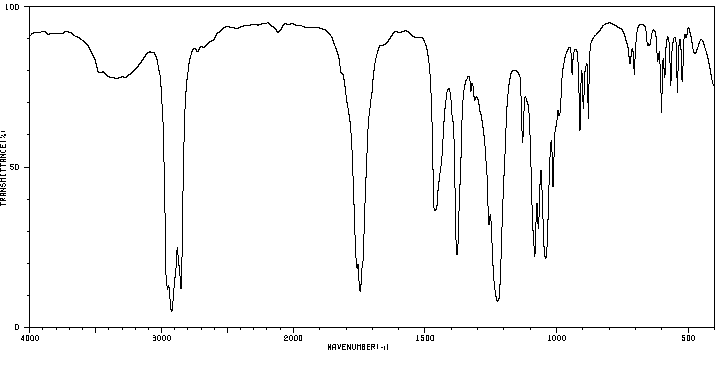tetra-O-acetyl-β-D-xylopyranose | 4049-33-6
中文名称
——
中文别名
——
英文名称
tetra-O-acetyl-β-D-xylopyranose
英文别名
1,2,3,4-tetra-O-acetyl-β-D-xylopyranose;1,2,3,4-tetra-O-acetyl-β-D-xylopyranoside;β-D-xylopyranose tetraacetate;tetra-O-acetyl-β-D-xylose;1,2,3,4-Tetra-O-acetyl-beta-D-xylopyranose;[(3R,4S,5R,6S)-4,5,6-triacetyloxyoxan-3-yl] acetate
CAS
4049-33-6
化学式
C13H18O9
mdl
MFCD00069790
分子量
318.281
InChiKey
MJOQJPYNENPSSS-XQHKEYJVSA-N
BEILSTEIN
——
EINECS
——
-
物化性质
-
计算性质
-
ADMET
-
安全信息
-
SDS
-
制备方法与用途
-
上下游信息
-
文献信息
-
表征谱图
-
同类化合物
-
相关功能分类
-
相关结构分类
物化性质
-
熔点:123-125 °C
-
沸点:362.9±42.0 °C(Predicted)
-
密度:1.29±0.1 g/cm3(Predicted)
-
稳定性/保质期:
在常温常压下保持稳定
计算性质
-
辛醇/水分配系数(LogP):-0.2
-
重原子数:22
-
可旋转键数:8
-
环数:1.0
-
sp3杂化的碳原子比例:0.692
-
拓扑面积:114
-
氢给体数:0
-
氢受体数:9
安全信息
-
危险性防范说明:P261,P305+P351+P338
-
危险性描述:H302,H315,H319,H335
-
储存条件:请将药品存放在避光、通风干燥的地方,并密封保存。
SDS
上下游信息
-
上游原料
中文名称 英文名称 CAS号 化学式 分子量 —— α-D-xylopyranose tetraacetate 1233-03-0 C13H18O9 318.281 -
下游产品
中文名称 英文名称 CAS号 化学式 分子量 —— α-D-xylopyranose tetraacetate 1233-03-0 C13H18O9 318.281 —— Primeverose-heptaacetat 18431-63-5 C25H34O17 606.535 —— 2,3,4-tri-O-acetyl-β-D-xylopyranose 70135-47-6 C11H16O8 276.243 —— methyl 2,3,4-tri-O-acetyl-D-glucopyranuronate —— C13H18O10 334.28 —— n-Hexyl O-β-D-xylopyranosyl-(1->6)-β-D-glucopyranoside 133084-29-4 C17H32O10 396.435 —— 1,5-anhydro-2,3,4-tri-O-acetyl-D-xylitol 19200-32-9 C11H16O7 260.244 —— butyl-β-D-xyloside 6743-65-3 C9H18O5 206.239 —— Phenyl 2,3,4-tri-O-acetyl-β-D-xylopyranoside 5041-91-8 C17H20O8 352.341 —— heptyl β-D-xylopyranoside 6743-67-5 C12H24O5 248.32 —— 4-methoxyphenyl 2,3,4-tri-O-acetyl-β-D-xylopyranoside 13299-05-3 C18H22O9 382.367 —— 1-octyl-β-D-xylopyranoside 6743-68-6 C13H26O5 262.346 —— 1-dodecyl β-D-xylopyranoside 101791-30-4 C17H34O5 318.454 —— Decyl β-D-Xylopyranoside 101453-23-0 C15H30O5 290.4 —— 1-nonyl β-D-xylopyranoside —— C14H28O5 276.373 —— Gal(b1-3)Xyl(b)-O-EtPh 144683-61-4 C19H28O10 416.425 —— Gal(b1-4)Xyl(b)-O-EtPh 144683-62-5 C19H28O10 416.425 甲基-β-D-吡喃木糖苷 methyl-β-D-xylopyranoside 612-05-5 C6H12O5 164.158 —— 2-azidoethyl β-D-xylopyranoside 443795-21-9 C7H13N3O5 219.197 —— (6-acetoxy-2-naphthyl)-2,3,4-tri-O-acetyl-β-D-xylopyranoside 940284-51-5 C23H24O10 460.438 —— naphthalene-1,7-diyl bis(2,3,4-tri-O-acetyl-β-D-xylopyranoside) —— C32H36O16 676.628 - 1
- 2
反应信息
-
作为反应物:描述:参考文献:名称:Regioselective heterogeneous O-deacylation of polyacylated sugars摘要:DOI:10.1016/s0008-6215(00)90208-8
-
作为产物:参考文献:名称:The Acid-catalyzed Anomerization of Acetylated Aldopyranoses1摘要:DOI:10.1021/ja01515a041
文献信息
-
Glycosynthase with Broad Substrate Specificity - an Efficient Biocatalyst for the Construction of Oligosaccharide Library作者:Jinhua Wei、Xun Lv、Yang Lü、Gangzhu Yang、Lifeng Fu、Liu Yang、Jianjun Wang、Jianhui Gao、Shuihong Cheng、Qian Duan、Cheng Jin、Xuebing LiDOI:10.1002/ejoc.201201507日期:2013.4A versatile glycosynthase (TnG-E338A) with strikingly broad substrate scope has been developed from Thermus nonproteolyticus β-glycosidase (TnG) by using site-directed mutagenesis. The practical utility of this biocatalyst has been demonstrated by the facile generation of a small library containing various oligosaccharides and a steroidal glycoside (total 25 compounds) in up to 100 % isolated yield
-
Synthesis and evaluation of xylopyranoside derivatives as “decoy acceptors” of human β-1,4-galactosyltransferase 7作者:Juan Francisco García-García、Guillermo Corrales、Josefina Casas、Alfonso Fernández-Mayoralas、Eduardo García-JuncedaDOI:10.1039/c0mb00206b日期:——Proteoglycans (PGs), including heparan sulfate forms, are important regulators of tumor progression. In the PGs biosynthetic process, the core protein is synthesized on a ribosomal template and the sugar chains are assembled post-translationally, one sugar at a time, starting with the linkage of xylose to a serine residue of the core protein and followed by galactosidation of the xylosylprotein. Hydrophobic xylopyranosides have been previously shown to prime heparan sulfate synthesis, a property that was required to cause growth inhibition of tumor cells. To know if the antiproliferative activity of synthetic xylopyranosides is related to their ability to act as âdecoy acceptorsâ of xylosylprotein 4-β-galactosyltransferase, we have heterologously expressed the catalytic domain of the human β-1,4-GalT 7 and studied the ability of a variety of synthetic xylopyranoside derivatives to act as substrates or inhibitors of the recombinant enzyme.
-
Stereoselective acetylation of hemicellulosic C5-sugars作者:Zachary D. Herde、Prathap D. John、Dania Alvarez-Fonseca、Jagannadh Satyavolu、Christopher T. BurnsDOI:10.1016/j.carres.2017.03.008日期:2017.4dimethylaminopyridine (DMAP) is described. The peracetylated d-xylose and l-arabinose alpha pyranose anomers 2α and 5α are obtained in 97% and 56% yields respectively. The peracetylated d-xylose beta pyranose anomer 2β is obtained in 71% yield through simple modification of the reaction conditions. Details regarding synthesis and isolation optimization studies under different conditions are presented below
-
Synthesis, surface properties, and biocompatibility of 1,2,3-triazole-containing alkyl β-d-xylopyranoside surfactants作者:E. Davis Oldham、Srivenu Seelam、Carolina Lema、Renato J. Aguilera、Jennifer Fiegel、Stephen E. Rankin、Barbara L. Knutson、Hans-Joachim LehmlerDOI:10.1016/j.carres.2013.06.020日期:2013.9β-xylopyranosides with 8, 10, or 12 carbons caused toxicity via apoptosis, with CC50 values ranging from 26-890 μM. The two longest chain compounds did form stable monolayers at the air-water interface over a range of temperatures, although a brief transition to an the unstable monolayer was observed.我们对半纤维素生物质衍生的表面活性剂的开发感兴趣,因为它们是药物,个人护理产品和其他洗涤剂中的潜在成分。此类表面活性剂在哺乳动物细胞中应表现出低毒性。在这项研究中,我们使用铜催化的叠氮化物-炔烃(CuAAC)“点击”反应,从木糖中分4步从叠氮化物和炔烃合成了一系列烷基或氟代烷基β-吡喃吡喃糖苷。评价纯化产物的表面活性剂性质和生物相容性。与其他基于碳水化合物的表面活性剂不同,差示扫描量热法未观察到液晶行为。短链(6个碳)和长链(> 12个碳)的含三唑的β-吡喃吡喃糖苷在1至1000μM的浓度范围内无毒性。含三唑的具有8、10或12个碳的β-吡喃吡喃糖苷通过细胞凋亡引起毒性,CC50值为26-890μM。尽管观察到短暂转变为不稳定的单分子层,但两种最长链的化合物确实在一定温度范围内在空气-水界面上形成了稳定的单分子层。
-
Chain extensions from C-1 and C-5 of D-xylopyranose derivatives作者:Regine Blattner、Robert J. Ferrier、Robyn RennerDOI:10.1039/c39870001007日期:——Free radicals produced successively at C-5 and C-1 from corresponding D-xylopyranose-based bromides add to acrylonitrile and methyl acrylate to give products with β-propionitrile or β-propionate substituents at these positions; some steric control can be achieved in the reactions, and the 4,8-anhydroundecanose derivative (13) is produced with good selectivity.
表征谱图
-
氢谱1HNMR
-
质谱MS
-
碳谱13CNMR
-
红外IR
-
拉曼Raman
-
峰位数据
-
峰位匹配
-
表征信息
同类化合物
(甲基3-(二甲基氨基)-2-苯基-2H-azirene-2-羧酸乙酯)
(±)-盐酸氯吡格雷
(±)-丙酰肉碱氯化物
(d(CH2)51,Tyr(Me)2,Arg8)-血管加压素
(S)-(+)-α-氨基-4-羧基-2-甲基苯乙酸
(S)-阿拉考特盐酸盐
(S)-赖诺普利-d5钠
(S)-2-氨基-5-氧代己酸,氢溴酸盐
(S)-2-[[[(1R,2R)-2-[[[3,5-双(叔丁基)-2-羟基苯基]亚甲基]氨基]环己基]硫脲基]-N-苄基-N,3,3-三甲基丁酰胺
(S)-2-[3-[(1R,2R)-2-(二丙基氨基)环己基]硫脲基]-N-异丙基-3,3-二甲基丁酰胺
(S)-1-(4-氨基氧基乙酰胺基苄基)乙二胺四乙酸
(S)-1-[N-[3-苯基-1-[(苯基甲氧基)羰基]丙基]-L-丙氨酰基]-L-脯氨酸
(R)-乙基N-甲酰基-N-(1-苯乙基)甘氨酸
(R)-丙酰肉碱-d3氯化物
(R)-4-N-Cbz-哌嗪-2-甲酸甲酯
(R)-3-氨基-2-苄基丙酸盐酸盐
(R)-1-(3-溴-2-甲基-1-氧丙基)-L-脯氨酸
(N-[(苄氧基)羰基]丙氨酰-N〜5〜-(diaminomethylidene)鸟氨酸)
(6-氯-2-吲哚基甲基)乙酰氨基丙二酸二乙酯
(4R)-N-亚硝基噻唑烷-4-羧酸
(3R)-1-噻-4-氮杂螺[4.4]壬烷-3-羧酸
(3-硝基-1H-1,2,4-三唑-1-基)乙酸乙酯
(2S,4R)-Boc-4-环己基-吡咯烷-2-羧酸
(2S,3S,5S)-2-氨基-3-羟基-1,6-二苯己烷-5-N-氨基甲酰基-L-缬氨酸
(2S,3S)-3-((S)-1-((1-(4-氟苯基)-1H-1,2,3-三唑-4-基)-甲基氨基)-1-氧-3-(噻唑-4-基)丙-2-基氨基甲酰基)-环氧乙烷-2-羧酸
(2S)-2,6-二氨基-N-[4-(5-氟-1,3-苯并噻唑-2-基)-2-甲基苯基]己酰胺二盐酸盐
(2S)-2-氨基-N,3,3-三甲基-N-(苯甲基)丁酰胺
(2S)-2-氨基-3-甲基-N-2-吡啶基丁酰胺
(2S)-2-氨基-3,3-二甲基-N-(苯基甲基)丁酰胺,
(2S)-2-氨基-3,3-二甲基-N-2-吡啶基丁酰胺
(2S,4R)-1-((S)-2-氨基-3,3-二甲基丁酰基)-4-羟基-N-(4-(4-甲基噻唑-5-基)苄基)吡咯烷-2-甲酰胺盐酸盐
(2R,3'S)苯那普利叔丁基酯d5
(2R)-2-氨基-3,3-二甲基-N-(苯甲基)丁酰胺
(2-氯丙烯基)草酰氯
(1S,3S,5S)-2-Boc-2-氮杂双环[3.1.0]己烷-3-羧酸
(1R,5R,6R)-5-(1-乙基丙氧基)-7-氧杂双环[4.1.0]庚-3-烯-3-羧酸乙基酯
(1R,4R,5S,6R)-4-氨基-2-氧杂双环[3.1.0]己烷-4,6-二羧酸
齐特巴坦
齐德巴坦钠盐
齐墩果-12-烯-28-酸,2,3-二羟基-,苯基甲基酯,(2a,3a)-
齐墩果-12-烯-28-酸,2,3-二羟基-,羧基甲基酯,(2a,3b)-(9CI)
黄酮-8-乙酸二甲氨基乙基酯
黄荧菌素
黄体生成激素释放激素(1-6)
黄体生成激素释放激素 (1-5) 酰肼
黄体瑞林
麦醇溶蛋白
麦角硫因
麦芽聚糖六乙酸酯
麦根酸








